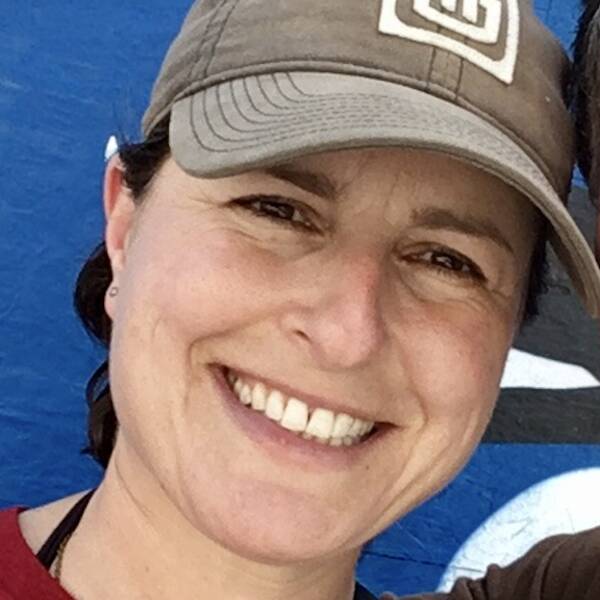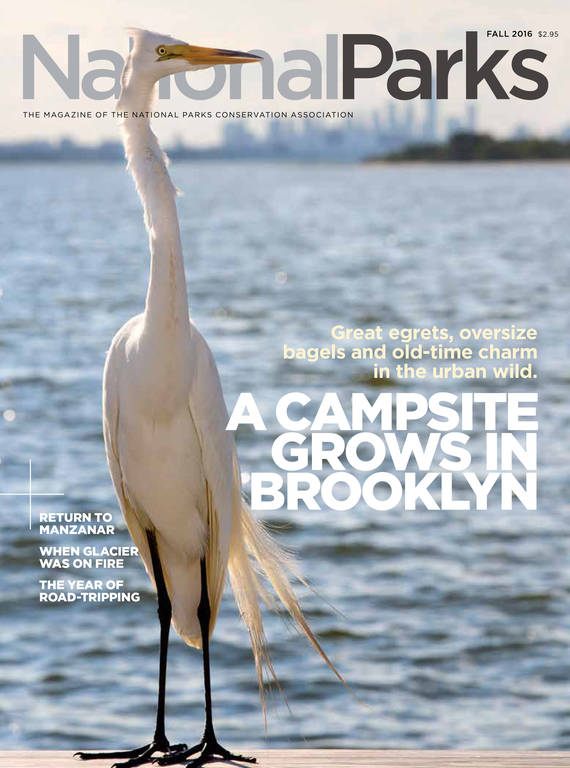Fall 2016
Songs of the Wild
Celebrating national parks with new music in the great outdoors.
On a glorious Saturday in June, seven musicians dressed in black stood in a semicircle on the grass near the entrance of a Shenandoah National Park visitor center. They wore sunglasses and hiking shoes. With a light breeze lifting the American flag overhead, a flutist, clarinetist, horn player, cellist, violist and violinist played “From Noon to Noon,” a piece by Daniel Pesca, which opens with a flute solo and imagines a sunny day-long excursion into a park.
The ensemble finished, and violinist Hanna Hurwitz showed a visitor her handmade carbon fiber violin — better suited than her 19th-century Belgian instrument for outdoor play. Abruptly, she turned her attention to the neck of the violin, where a red speck crept under the strings. “Oh,” she said. “A spider!”
To celebrate the National Park Service centennial, these musicians brought original compositions to audiences across the country this summer through a program called Music in the American Wild. Their tour of 12 parks and historic sites began in June in the Southeast and finished in August in the Pacific Northwest. The contemporary classical pieces were inspired by the parks and include many sounds suggesting the noises in nature: wind blowing through prairie grasses, bears lumbering, frogs croaking or crickets chirping.
“We don’t often associate parks with music,” said flutist and ensemble director Emlyn Johnson, who received a Doctor of Musical Arts degree from the Eastman School of Music at the University of Rochester last year. “We want to help people see parks as a places for artistic inspiration.”
The idea came to Johnson and cellist Dan Ketter nearly two years ago when the couple was hiking in New York’s Letchworth State Park and fantasizing about performing in nature rather than in concert halls. They learned about the Park Service’s centennial, and their plan began to take shape. With the help of a $20,000 grant from the National Endowment for the Arts’ “Imagine Your Parks” program, Johnson commissioned 11 composers to write the pieces and hired the musicians, all academics in their 20s and 30s who are Eastman alumni.
Though the music is celebratory, Johnson’s diverse group of composers created a range of work: One wrote about Wizard Island at Crater Lake National Park. One considered human encroachment on animal territory. One borrowed a title, “Everything Flowing,” from a passage in John Muir’s book, “My First Summer in the Sierra.” And another explored wide open landscapes, from the Pacific Ocean to prairie grasses in Kansas. Some of the music is haunting; other pieces are jaunty and playful.
Composer Robert Morris, a 74-year-old member of the Eastman faculty who has been composing since he was 9, is known for his works inspired by nature but only rarely has written music meant to be performed outside. Morris said his commissioned piece, “Birds Soaring over Mountain Paths,” is about the beauty and grandeur of parks but also reflects another side of the mountains: unforgiving surfaces, dangerous ledges and rough trails. “Being exposed to mountains, canyons, beautiful meadows — it’s all incredibly germinating for composers,” Morris said.
At Mammoth Cave National Park in Kentucky in June, the ensemble descended 69 steps to the chilly underground rotunda, carrying instruments, music stands and recording equipment. They played there intermittently for a few hours, surprising more than 1,000 touring visitors. With the help of a ranger, the musicians discovered natural spots in the cave that reverberated with a B-flat pitch when they tapped their feet or clapped their hands, and they delighted in matching the note on their instruments. Ketter described the setting as “an indoor Mars,” noting that he’d never played in a place so strange and may never do so again.
“It was a different way to experience the size and sensuality of the cave through all your senses,” said public information officer Vickie Carson. The cave was an ideal spot for introducing visitors to a new kind of music, she said: “It’s such an alien environment, your mind is open to almost anything.”
One piece called for each of them to rattle a colorful desk bell. Percussionist Colleen Bernstein, the youngest in the ensemble at 22, played instruments as diverse as a frog-shaped guiro, which makes a ratchet sound, to steel square tubing and a threaded metal rod from Lowe’s. Chris Chandler, who composed the Shenandoah piece, discovered the pleasing sound of metal mixing bowls when his toddler was playing with them. He incorporated those into his work and shipped the bowls to Bernstein for the tour.
Ketter, who is in a doctoral program at Eastman, said performing in untraditional venues is a growing trend among young ensembles, but the musicians were apprehensive about bringing abstract pieces to campers and hikers. “When people think of new music, it can seem out of touch or super intellectual,” Ketter said. “We were very excited to see that people related. The applause and standing ovations were a good metric.”
Emily Jones, a senior program manager at NPCA, which has helped promote Music in the American Wild, said artists have always been an integral part of the parks. “In this centennial year,” she said, “we want to remind people of the importance of the parks not just as places for recreation but also as laboratories.”
When the group arrived at Shenandoah, they recorded a session under gray and drizzly skies at Big Meadows. The next day, they hiked with their instruments up Hawksbill Mountain, where a Boy Scout troop from southern Maryland enjoyed an impromptu performance. Later that day, they performed in an auditorium and again in the meadow.
Horn player Lauren Becker, a professor at SUNY Potsdam, said the horn is historically an outdoor instrument used to get the attention of townsfolk or call hounds for a foxhunt. Atop Hawksbill, Becker heard the sound of her horn echoing back to her and described it as a larger-than-life experience. Elsewhere, they heard birds chirping and grass rustling while they played. Sometimes, wind turned the music pages or bugs buzzed by or sun glowed in their faces.
“It’s more unpredictable outdoors,” Becker said. “And a lot of fun.”
About the author
-
 Melanie D.G. Kaplan Author
Melanie D.G. Kaplan AuthorMelanie D.G. Kaplan is a Washington, D.C.-based writer. She is the author of the book "LAB DOG: A Beagle and His Human Investigate the Surprising World of Animal Research" (Hachette/Seal Press, 2025).



